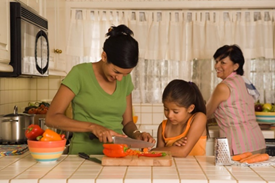9.4: Engaging Families
Teachers can use the following strategies to help families to develop their children’s mathematical understanding:
- Communicate to families
- the broader aspects of developing number sense; for example, using counting in real-life situations, comparing numbers and discussing which is more or less, making estimations (e.g., How many grapes are in this bowl?), and solving simple addition and subtraction problems.
- what classification and patterning are about and how they contribute to children’s understanding of mathematics.
- the importance of early measuring experiences and types of measurement experiences they can do with children.
- that mathematical reasoning is being able to think mathematically and explore different ways of solving problems
- Remind parents that daily use of numbers (which are everywhere!) can become learning experiences for children.
- Provide number-related games and books that children can take home or that families can make or purchase.
- Encourage parents to
- involve children in everyday measurement experiences
- refer to shapes in the environment when talking with children
- use spatial words in everyday interactions with children
- recognize math in everyday events and interactions and turn them into learning experiences[1]

- The California Preschool Curriculum Framework, Volume 1 by the California Department of Education is used with permission ↵

